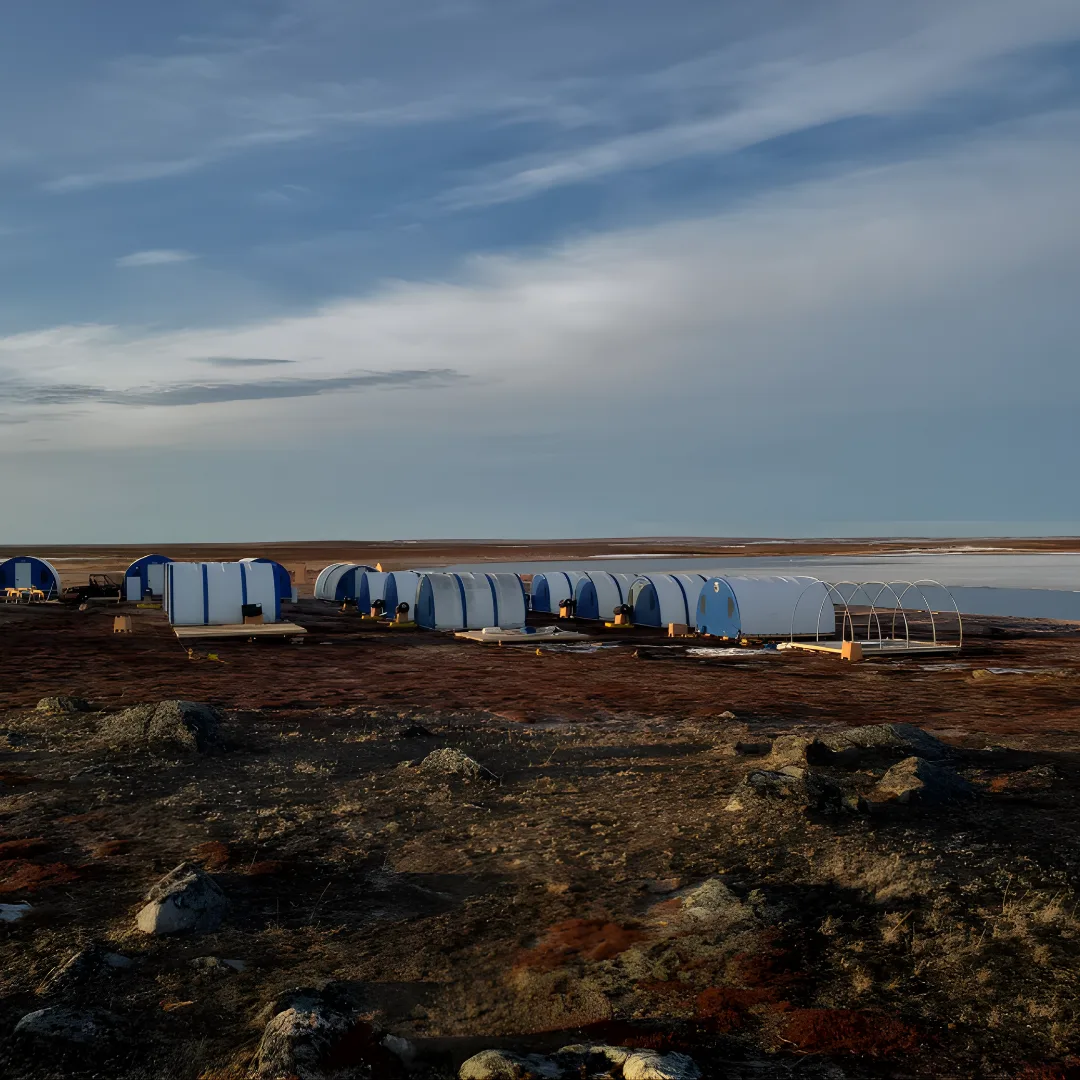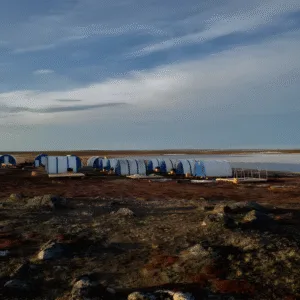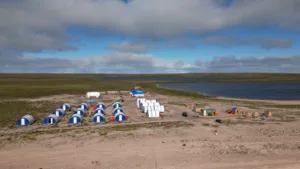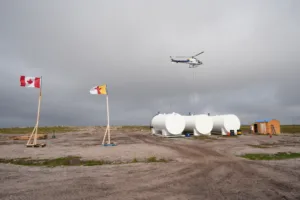
This article is based on the interview with Dr. Rebecca Hunter. Presented company is a client and this should be considered as sponsored content!
In the dynamic world of uranium exploration, few names carry the weight of expertise and passion quite like Dr. Rebecca Hunter. As the newly appointed CEO of Geiger Energy—a company born from the merger of Forum Energy Metals and Baseload Energy—Dr. Hunter is steering a vehicle poised to capitalize on one of the most underexplored yet promising uranium districts in North America: the Thelon Basin. Dr. Hunter shares insights into the merger's completion, the flagship Aberdeen project, complementary assets like the Hook Project, which hosts the ACKIO discovery, and her bullish outlook on the uranium market. What emerges is a story of strategic consolidation, high-potential targets, and a focused approach to discovery in a sector ripe for revival.
The Merger: From Discussions to a Unified Geiger Energy
The formation of Geiger Energy marks a significant milestone in Dr. Hunter's career and the uranium junior space. Discussions began as early as March, but momentum accelerated in June when Dr. Hunter assumed leadership. "It's like any transaction—they take a long time," she explains. "But once we started getting the momentum back in June when I took over, then everything has been pretty smooth. It's just a process that takes time to put all that paperwork together."
This was Dr. Hunter's first merger, presenting a steep learning curve involving extensive legal coordination. Despite the challenges, the deal closed smoothly, and Geiger Energy is now operational. The board remains largely intact: Stephen Stewart serves as Chairman, with James Sykes—former CEO of Baseload Energy—transitioning to a director and technical advisor role. "I work with him quite a bit, picking his brain especially on the old Baseload portfolio," Dr. Hunter notes.
New addition Janet Meiklejohn, previously a director at Forum, joins the board. The operational team blends talent from both legacy companies, creating a merged technical group. A key priority is recruiting a VP of Exploration—a "technical, strong operational" leader capable of innovative thinking in emerging districts like the Thelon. "You need that kind of out-of-the-box thinker and person that's willing to step out there and really try to make discoveries," Dr. Hunter emphasizes. This hire will alleviate her dual-role burdens and strengthen on-the-ground execution.
Aberdeen Project: Pounds in the Ground and Untapped Potential
At the heart of Geiger Energy's portfolio is the Aberdeen project in the Thelon Basin, Nunavut—a vast land package spanning trends with proven mineralization and dozens of untested targets. Aberdeen stands out for its existing high-grade uranium zones, including Tatiggaq and Qavvik. These deposits feature significant intercepts, such as 2.25% U3O8 over 11,1 meters, providing a foundation for resource delineation.
However, the summer 2025 program prioritized exploration over delineation to "get the momentum and get the eyes up there in the Thelon." The standout result: the new Loki discovery. "Extreme alteration in the sandstone and then that first weak mineralization... at the sandstone-basement unconformity," Dr. Hunter describes. Initial radioactivity readings hit 500-600 counts per second (cps), with geochemistry assays pending to convert these to uranium grades.
Loki reshapes the geological model, demonstrating Athabasca-style unconformity potential in the Thelon. "It's a big game changer. It's just a small little piece of the puzzle, but it's really showing that we have the same sort of Athabasca systems." Despite a late start due to the merger (announced end-June), weather delays, and an early winter halting operations mid-September, the team completed ~5,000 meters of drilling across multiple trends.




Targeting Methodology: Gravity Anomalies and Structural Trends
Aberdeen boasts over 50 high-priority exploration targets, mostly untested. Primary guidance comes from gravity surveys, which highlight clay alteration envelopes characteristic of uranium deposits. Unlike the Athabasca Basin's discrete conductors, Thelon relies on fault zones mapped via magnetics and resistivity.
"Nine out of 10 of them are actual alteration systems," Dr. Hunter says of tested gravity anomalies. Key trends include:
• Judge Sissons Trend: Hosts the Tatiggaq deposit and a ~30 km untested fault zone with extreme alteration in historical holes (e.g., Lobster grid).
• Qavvik Trend: Includes the Qavvik deposit, positioned south of the Thelon Fault.
• Thelon Fault Trend: The Bjorn, Ned and Mammoth targets fall along this Trend.
• Subsidiary Trends: Numerous other ENE – trends that are subparallel through out the property, including ones that host the Kiggivik deposits.
Orano's nearby deposits provide context: End on the Tatiggaq trend, Andrew on a southern subsidiary, and Kiggavik between the Thelon Fault and Qavvik trends. "You've got all these kind of faults ripping through here and lots of targets," Dr. Hunter illustrates.
The Loki anomaly spans >1 km along a 1.2 km trend, with widespread alteration. Planned follow-up includes detailed resistivity surveys to refine fault mapping alongside gravity data.
Upcoming Drilling: Aggressive Exploration at Loki and Beyond
Geiger's strategy remains exploration-focused, with Loki as one of the priorities. Objectives include step-out drilling to chase mineralization along faults and narrowing targets within the broad anomaly.
With enhanced funding post-merger, Geiger aims to deploy 2-3 drills for broader coverage, including potential delineation at Tatiggaq and Qavvik. "What we really want to accomplish here is getting a lot of good funding and being able to really hammer not only all these exploration targets... but we'll need two or three drills to do that."
Challenges like the late 2025 start limited access to high-priority areas (e.g., Northern Targets). Future programs will leverage summer windows aggressively.
Complementary Assets: Hook (ACKIO) and Winter Drilling
Geiger's portfolio exceeds 350,000 hectares across >10 projects in the Athabasca and Thelon basins. The Hook project in Saskatchewan—featuring the near-surface ACKIO discovery—serves as a winter-counterpart to Aberdeen's summer-only access.
"Hook we really consider as an asset that we can work in the winter and expand that," Dr. Hunter explains. Plans call for 2,000-3,000 meters in winter 2026, targeting clay alteration envelopes outlined in 2024 drilling. ACKIO's basement-hosted, basement-style structures mirror Thelon geology—no conductors, gravity-driven targeting—making it "extremely complementary."
Mid-term goals emphasize expanding beyond ACKIO to the broader Hook area rather than immediate resource definition. "For 2025, it's actually moving outboard from ACKIO and looking at those clay alteration envelopes."
Other Portfolio Projects: Optionality and Partnerships
While Aberdeen and Hook are flagships, Geiger holds diverse assets:
• Northwest Athabasca JV: Optioned to Global Uranium; discussions ongoing for winter 2025/2026 or summer work. A camp is in place from prior efforts.
• Janice Lake: Copper-focused, held for optionality amid rising prices. Not a Geiger core focus but open to partners.
• Clearwater: Proximity to NexGen's successes (e.g., Arrow, Triple R trends) and the Patterson Lake Corridor makes it intriguing. Sandwiched in a "good neighborhood," it warrants re-evaluation with modern targeting.
• Additional Athabasca Projects: In good standing; partnerships sought to advance without diluting focus.
Long-term, Geiger prioritizes flagships but eyes spin-outs, sales, or JV partnerships for non-core assets to unlock value. "We have lots of optionality... looking for partners on that."
Managing Costs: Shallow Targets in the Thelon
A common misconception labels Thelon exploration as prohibitively expensive due to remoteness and lack of infrastructure. Dr. Hunter counters: Shallow targets (<300 meters typical) allow testing multiple anomalies per meter drilled, making costs comparable—or lower—than deep Athabasca holes.
"It's not just the costs, but it's also the amount of targets you can test... if you're drilling really deep targets in the Athabasca versus shallow targets in the Thelon, it's comparable, if not cheaper." Geiger is fully funded for Athabasca work, with forward plans pending.
News Flow, Catalysts, and Market Outlook
Near-term catalysts include:
• Releases on remaining 2025 Aberdeen results (geochemistry, Loki details, Lobster/Tarzan trends).
• Videos and updates showcasing alteration systems.
• Hook winter program announcements, highlighting 2024 grids.
Geiger's strategy: Focus on fewer projects executed excellently—Aberdeen summers, Hook winters—both with known mineralization.
On the uranium market, Dr. Hunter is unequivocally bullish. "The uranium thesis is stronger than ever." Majors like Cameco trade above $140/share (from her early days at ~$20). Daily positive news—reactor builds, supply deficits—underscores demand. "It's a metal that's needed... fundamental element that has long-term demand."
Juniors, battered for over a decade, deserve trickle-down benefits. North America's Thelon Basin positions Canada as a secure supply source. "We really have to start thinking safe supply... this other basin in the North that also can be a major supplier."
Conclusion: A New Era for Geiger Energy
Under Dr. Rebecca Hunter's leadership, Geiger Energy embodies focused aggression in uranium exploration. With pounds in the ground at Aberdeen, a pipeline of >50 targets, winter-accessible Hook, and a seasoned team, the company is primed for discoveries. As the uranium bull market roars, Geiger's shallow, high-density targeting in the Thelon could deliver the next major find. Investors watching the sector would do well to monitor upcoming news flow—Loki's assays and Hook's winter drills may prove pivotal.
Dr. Hunter's parting words resonate: "I think it's time." For Geiger Energy, that time is now.
Watch the interview with Rebecca Hunter here:
Disclaimer: This article is not a recommendation to buy any shares, products, or services. Always conduct your due diligence and consult with a financial advisor.
Sign up to our free monthly newsletter to recieve the latest on our interviews and articles.
By subscribing you agree to receive our newest articles and interviews and agree with our Privacy Policy.
You may unsubscribe at any time.
We use cookies to improve your experience on our site. By using our site, you consent to cookies.
Websites store cookies to enhance functionality and personalise your experience. You can manage your preferences, but blocking some cookies may impact site performance and services.
Essential cookies enable basic functions and are necessary for the proper function of the website.
These cookies are needed for adding comments on this website.
Statistics cookies collect information anonymously. This information helps us understand how visitors use our website.
Google Analytics is a powerful tool that tracks and analyzes website traffic for informed marketing decisions.
Service URL: policies.google.com
You can find more information in our Privacy Policy.